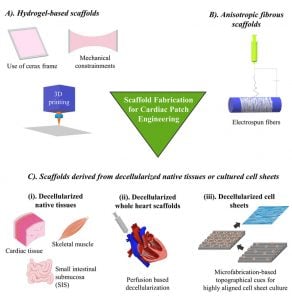
Cardiovascular diseases are the major causes of death worldwide. As a part of their ongoing project to construct a tissue engineered cardiac patch to repair damaged heart muscle, Dr. Zhao’s Lab team has recently reviewed contemporary techniques to fabricate heart-specific matrices for cardiac patch engineering. This invited review titled “Constructing biomimetic cardiac tissues: a review of scaffold materials for engineering cardiac patches” was published by Dhavan Sharma (PhD candidate), Morgan Ferguson (MS student), Dr. Timothy J. Kamp (collaborator at University of Wisconsin Madison), and Dr. Feng Zhao in Emergent Materials, Springer. (https://doi.org/10.1007/s42247-019-00046-4)
Engineered tissues are composed of two major components: cells and the extracellular matrix. This review focuses on the latter one, which holds the cells in a 3D space. Recent advances in scaffold fabrication techniques have enabled scientists to a generate heart-specific microenvironment within the engineered tissue constructs. These cardiac-specific scaffolds can be developed using synthetic polymers or native tissues as well as cell sheets. This article will provide readers with a timely review about different fabrication methods that have been employed to develop scaffold materials which ultimately have been used to engineer cardiac patches.